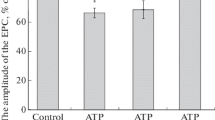Abstract
The effects of four xanthine derivatives, caffeine, caffeine benzoate, theophylline, and bromtheophylline, on sodium channels in internally perfused rat dorsal root ganglion neurons were studied under voltage-clamp and whole-cell patch-clamp conditions. Reversible acceleration, enhancement of the amplitude of sodium currents, and shifts of the current-voltage relation (plotted for their maxima), as well as of the steady-state inactivation curve toward more negative potentials, were observed at external applications of the above substances in the concentrations of 0.2–4.0 mM. Under long exposures, inactivation of sodium currents became slower in a part of the cells. Yet, when the exposure to 4 mM or higher concentrations was longer than 10 min, a rise in the passive conductance was obvious, and functional state of the cells became worse. Blocking effects of the xanthine derivatives on transient or delayed potassium currents were not observed. Thus, agonistic action of xanthines on sodium channels has been demonstrated, and it is supposed that a considerable component of their pharmacological effects is provided by the action on Na+/Ca2+ exchange.
Similar content being viewed by others
References
R. H. Kramer, R. Mokkapatti, and E. S. Levitan, “Effects of caffeine on intracellular calcium, calcium current and calcium-dependent potassium current in anterior pituitary GH3 cells,”Pflügers Arch.,426, 12–20 (1994).
M. A. Reiser, T. D'Suoza, and S. E. Dryer, “Effects of caffeine and 3-isobutyl-1-methylxanthine on voltage-activated potassium currents in vertebrate neurones and secretory cells,”Br. J. Pharmacol.,118, 2145–2151 (1996).
N. Shirokova and E. Rios, “Caffeine enhances intramembraneous charge movement in frog skeletal muscle by increasing cytoplasmic Ca2+ concentration,”J. Physiol.,493, 341–356 (1996).
Yu. Usachev, P. G. Kostyuk, and A. Verkhratsky, “3-isobutyl-1-methylxanthine (IBMX) affects potassium permeability in rat sensory neurones via pathways that are sensitive and insensitive to [Ca2+] in ,”Pflügers Arch.,430, 420–428 (1995).
P. G. Kostyuk, N. S. Veselovsky, and A. Ya. Tsindrenko, “Ionic currents in the somatic membrane of rat dorsal root ganglion neurons. 1. Sodium currents,”Neuroscience,6, 2423–2430 (1981).
O. P. Hamill, A. Marty, E. Neher, et al., “Improved patch-clamp techniques for high-resolution current recording from cells and cell-free membrane patches,”Pflügers Arch.,391, 85–100 (1981).
I. Moraidis and D. Bingman, “Epileptogenic actions of xanthines in relation to their affinities for adenosine A1 receptors inCA3 neurons of hippocampal slices (guinea pig),”Brain Res.,640, 140–145 (1994).
Author information
Authors and Affiliations
Rights and permissions
About this article
Cite this article
Parkhomenko, N.T., Yatsenko, L.N. & Kuksenok, A.M. Agonistic effects of xanthines on tetrodotoxin-sensitive sodium channels in the rat dorsal root ganglion neurons. Neurophysiology 29, 264–268 (1997). https://doi.org/10.1007/BF02461240
Received:
Issue Date:
DOI: https://doi.org/10.1007/BF02461240



